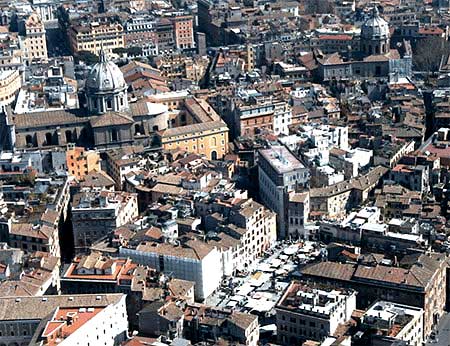By James Packer
 |
Fig. 1. The Theater of Pompey, looking
southeast, restored
model by Italo Gismondi in the Museum
of Roman civilization, Rome |
The Site

Fig.
2. The Campus Martius as it may have appeared before the
foundation of Rome |
The Theater of Pompey stood on the southern
section of ancient Rome’s Campus Martius, the Field of Mars.
As its name suggests, in the period when the Senate ruled Rome
(the “Republic,” 509 B.C.– 31 B.C.), this largely empty
space was the site where the Roman citizen army assembled
before marching out against the city’s enemies, and its chief
topographical features (marshes, streams, a sizeable lake) did
not encourage extensive construction. |
| But, by the late second century B.C. some buildings
were already beginning to go up, and after Pompey,
the conqueror of Asia Minor (Turkey) and Syria, constructed
his massive theater, in 55 B.C., the whole area
developed rapidly. By the early second century A.D., private
citizens and the emperors had filled the entire zone with
elegant public and private buildings. |

Fig.3. The plan of the Campus Martius in the first
century A.D.
|

Fig.
4. The modern Campo Marzio with the umbrellas of the week day
market, aerial view, looking southeast. The central building
with the rectangular white facade is the Pio Palace, the chief
structure built over the remains of the Theater of Pompey; the
large church (l.) is San Andrea della Valle; the more distant
church (r. rear) at the end of the Via dei Giubbonari is San
Carlo ai Catanar
|
The “Campo Marzio” today is the heart of modern
Rome’s “Centro Storico,” (historic center). |
